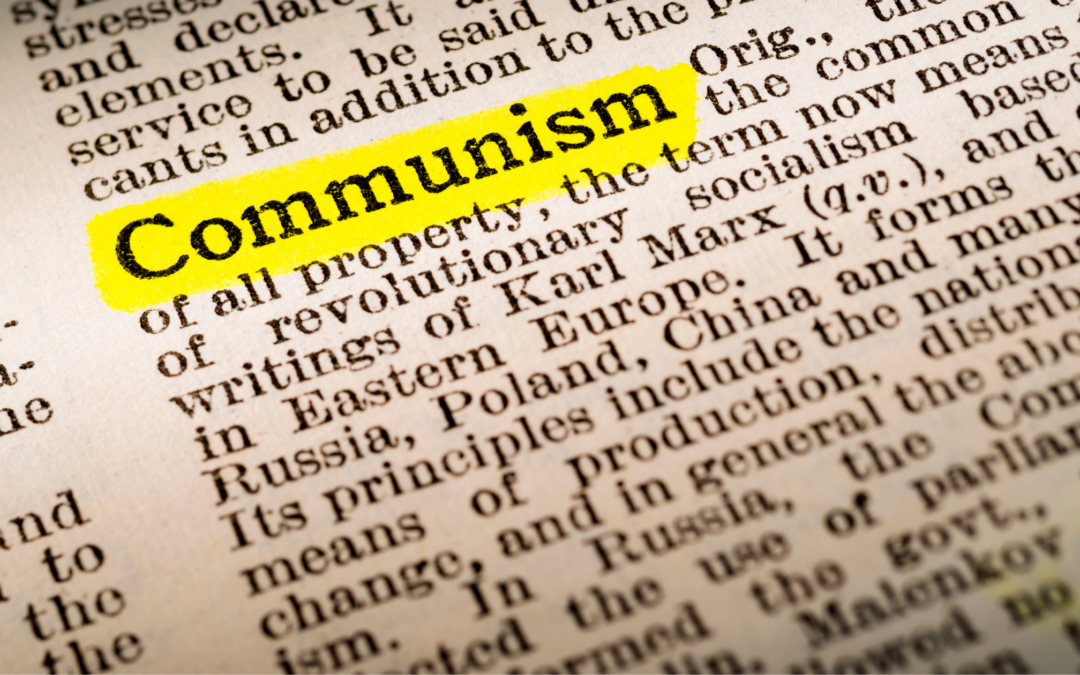Communism Explained: Principles, History, and Catholic Insights
This is the first in our series, The -Isms Encyclopedia: Historical and Philosophical Ideas Explained by Mr. Phillip Campbell.
I grew up in the waning days of the Cold War, and I always remember hearing a lot about the Soviets on the news. One day, when I was young, I asked my father, “Who are the Soviets?” My father told me, “They are the bad guys.” For much of my life, that was about all I knew about Russian Communism. It was not until I entered college and began the study of history in earnest that I came to understand why the Soviet Union were the “bad guys” and why so many nations and institutions—including the Catholic Church—viewed communism with the most profound hostility.
In my fifteen years of teaching, I think the same holds true for many Catholic youth today. They have imbibed enough to know that communism is wrong but struggle to explain what communism is, what Communists believe, and what precisely makes it bad.
This article will attempt to redress this by deep-diving into communism. What are the principles of communism, who were its pivotal players, how have experiments in communism played out, and what is the Catholic perspective on communist ideology?
Principles of Communism
The fundamental principles of communism are:
Universalism
Communism is a complex ideology that is universal in scope. That is, it makes claims about philosophy, politics, culture, and economics and offers a comprehensive vision that unifies these aspects of human society in a single worldview. Communism thus presents itself as the answer to every human problem. Communists argue its applicability to every place and culture.
Materialism
According to communism, matter is all that exists; there is no spirit and no immaterial realities. Human life is about satisfying material needs, and therefore, economics is the most basic function of society. Everything else humans do (e.g., art, culture, politics, religion, etc.) is part of a “superstructure” built on top of an economic base. Communism claims economics shapes human culture. Rooted in materialism, it denies the existence of the spiritual and positions itself as atheistic and opposed to religion.
Class Conflict and Collectivism
For most of human history, economics has been dominated by a conflict between two classes, the haves and the have-nots. The 1848 Communist Manifesto highlights historical struggles, such as plebeians vs. patricians in ancient Rome, peasants vs. feudal lords in medieval Europe, and workers vs. capitalists in the 19th century West. Human history is fundamentally a story about the attempts of the have-nots to obtain equitable economic conditions from the haves. Civilization progresses through this conflict. The idea of progress through conflict is called a “dialectical” movement. Communism’s ‘dialectical materialism’ teaches that social progress comes from conflicts over material conditions, with each conflict driving the have-nots closer to equality. Ultimately, equality means abolishing private property and complete collective ownership of all resources.
Exploitation of Labor and Alienation of Man
At every point in history, the haves were exploited by the have-nots for their labor. Workers have been “alienated” from the fruits of their labor. By alienation, communism means that workers have been forced to use their labor to produce goods that they themselves do not get to enjoy. The medieval peasant has to hand his crop over to his feudal lord, and the industrial laborer does not get to enjoy the profits of the goods he produces. The profit, according to Communists, is stolen by the owner classes, who keep the workers ground down in servitude.
Bourgeoisie Capitalism as the Final Stage of Development
Karl Marx, the founder of Communism, referred to modern industrial society as “bourgeois capitalism.” For communists, the word “capitalism” means an economy based on the control and investment of money by a small group of wealthy owners (“capitalists”). The capitalist class who benefits from this arrangement is called the bourgeoisie, a French word that means “middle class.” The capitalist owner class relied on the sweat of industrial laborers (Marx called “proletariat”) to work their factories.
Because of the rapid developments of industrial society, the conflict between the bourgeoisie and the proletariat would be the final conflict in the historical dialectic. The struggle between these two would result in a victory for the proletariat, the definitive triumph of the have-nots over the haves. It is important to note that communists see this as inevitable—the takeover of the proletariat is not a matter of if it will happen but when it will happen.
The Dictatorship of the Proletariat
In the final stages of this development, as worker’s revolutions broke out worldwide, an all-powerful central state would be needed to oversee the transition from capitalism to communism–what Marx called the “dictatorship of the proletariat.” In order to implement the new system, the state needed total power, but only temporarily, to ensure that communism was implemented and the bourgeoisie did not reassert itself. This dictatorial government would ensure strict equality, doing away with all classes, ethnic distinctions, and social constructs, creating a society of material equality where resources would be allocated “from each according to his ability, to each according to his needs,” as Marx famously said.
Once the state of pure communism was reached, the government would be unnecessary. The state, therefore, was seen as a temporary expedient that would wither away once the final communist unity was attained. In the meantime, the government was to be controlled by the Communist Party, which would be the sole legitimate voice of the working people.
Who’s Who of Communism
There have been philosophies we might describe as “communistic” floating around for millennia. For example, some characterize the communal society described in Plato’s Republic as communistic. At the same time, in Reformation Germany, the radical Anabaptists of Münster established a communistic theocracy in that city until they were defeated by the Catholic forces of Münster’s bishop. In the aftermath of the French Revolution, there were various proto-communist movements in Europe and the United States, such as the Icarian Movement of Étienne Cabet in the U.S. and the French socialist movement of Théodore Dézamy, who rejected capitalism and private property.
Karl Marx and Fridrich Engels
However, it was not until the German newspaper editor Karl Marx (1818-1883) and his associate Friedrich Engels (1820-1895) published the Communist Manifesto in 1848 that Communism in its modern form took shape. While the Manifesto called for a worldwide revolution of the proletariat (i.e., working classes), Marx’s 1867 tome Das Kapital provided the intellectual foundations of communism as a political, social, and economic philosophy. Marx and Engels are considered the founding fathers of communism, sometimes known as “Marxism.”
Vladimir Lenin and Leon Trotsky
In the Russian Revolution of 1917, Russian Communists such as Vladimir Lenin (1870-1924) and Leon Trotsky (1879-1940) adapted the principles of communism to suit the circumstances in Russia. Karl Marx had conceived of communism as something that would emerge out of industrial society; Russia, however, had never reached industrialism and was still an agricultural culture grounded in feudal tradition. Lenin, Trotsky, and the Russian Communists modified Marx’s principles to explain how a society could jump from agricultural to communist without going through the industrial-capitalist stage.
Joseph Stalin
Russian Communism is often described as “Leninism” or Bolsehvism” to distinguish the Russian variant from Marxism in general. Joseph Stalin (1878-1953), dictator of Russia from 1922 to 1953, further modified Communism in relation to the role of the dictatorship of the proletariat. Traditional Communist thought holds that the state will gradually “wither away” as the implementation of socialism reduces class distinction. But Stalin argued that the proletarian state must become stronger before it can wither away. The phrase “Stalinism” is sometimes used to describe the Leninist-Bolshevism in its most repressive, statist incarnation.
Mao Zedong
Similarly, in China, Mao Zedong (1893-1976) developed a brand of communism based not upon the industrial laborers as in Marx but upon millions of Chinese peasant laborers. Communism situated within its Chinese cultural context is known as Maoism.
Antonio Gramsci
In the West, communism was refined by the Italian thinker Antonio Gramsci (1891-1937), who argued that to succeed in the affluent West, Communism could not advance by political revolution alone. Rather, communists needed to change the entire culture to establish what he called cultural “hegemony” (superiority). Gramsci is often considered the father of the Western European and American branches of “activist” communism, which focuses on moving society towards communism by changing culture through film, print media, educational institutions, etc.
José Carlos Mariátegui La Chira
In Latin America, José Carlos Mariátegui La Chira (1894-1930) adapted Marxism to the conditions of Latin America, taking the struggle of indigenous peoples against European colonialism as an essential aspect of the fight against capitalism. Mariátegui’s thought would influence the thought of future Latin American Communists such as Fidel Castro, Che Guevara, and Evo Morales.
Communism in Practice
Wherever it has been tried, communism has fared very poorly. Whenever it has been tried, it has resulted in economic collapse, rampant poverty, inefficient bureaucracy, and repressive dictatorship. Russian dictator Joseph Stalin is believed to have killed around 20 million of his own people; China’s Mao Zedong caused the deaths of between 40 to 80 million, and Cambodia’s Pol Pot murdered 2.4 million Cambodians out of a population of 7 million. That is around 40% of the populace of Cambodia.
Catholicism, too, was ruthlessly attacked and suppressed wherever communists took power. The number of dead is not inconsiderable. For example, in Spain, over 2,000 Catholics were killed by Spanish Communists during the Spanish Civil War (1936-1939). The Catholic dead from Communism globally is incalculable.
Communism can be critiqued on many grounds, but its fundamental flaw as an economic system is that it denies the principle of self-interest. Essentially, communism treats human beings as a collective. Like ants in a hive, which can be manipulated as an aggregate without regard to their individual needs and interests. However, human beings do not function as a collective. We are social creatures but with strong individual identities inherent in our nature. When communism’s attempts to force human nature into a collective inevitably fail, the Communist authorities have no recourse but to impose their policies by brute force. Therefore, communism is ultimately a kind of utopianism, a fantasy that could never exist in reality. For this reason, communism has often been described as a system that “works in theory but not in practice.”
From the Russian Revolution of 1917, communism gradually spread until, by 1985, one-third of the world’s population lived under Communist regimes. These began to collapse dramatically throughout the late 1980s, beginning with the fall of Polish Communism in 1989 and culminating in the collapse of the Soviet Union in 1991. As of 2024, the only communist countries left are China, Cuba, Laos, Vietnam, and North Korea
From a Catholic Perspective
The principles of communism are absolutely antithetical to Catholicism. Its materialism and anti-supernaturalism alone make it incompatible with the faith, and that’s before we even consider its horrific track record on human rights abuses and the brutal disregard for human dignity. During the 20th century, Catholic authorities considered Communism the single greatest threat to the Church globally. It was condemned in principle and practice many times, most notably in the 1937 encyclical Divini Redemptoris (“On Atheistic Communism”) by Pope Pius XI.
In the Homeschool Connections Catalog
Several Homeschool Connections high school courses discuss Communism, directly and indirectly, including:
- Corruption and Communism: Modern China with Christopher Martin
- Totalitarianism in the 20th Century: Nazis and Soviets with Christopher Martin
- Economics as if People Matter with Phillip Campbell
- Revolution: The Progress of Liberalism with Phillip Campbell
- History and Culture of Imperial Russia with Carol Reynolds
- Modern European History with Phillip Campbell
- Renaissance to Modern History for Middle School (New World to Cold War) with Inshal Chenet
- History of Latin America with Phillip Campbell
Note that while adults cannot take our LIVE interactive courses, they are welcome to take the self-paced recorded versions through our Unlimited or Single Access programs.
Conclusion
In studying communism, we gain a clearer picture of an ideology that shaped our modern world and an appreciation of the profound challenges it presents to human dignity. Though alluring in theory, its principles have proven deeply flawed in practice. It has led to widespread suffering wherever implemented. From its materialistic foundations to its utopian aspirations, Communism stands in stark contrast to the Catholic view of the human person made in the image of God.
What are your thoughts on this topic? Join me and other homeschooling parents at our Homeschool Connections Community or our Facebook group to continue the discussion.
This is the first in a series, The -Isms Encyclopedia: Historical and Philosophical Ideas Explained by Mr. Phillip Campbell. Next up will be Romanticism.






